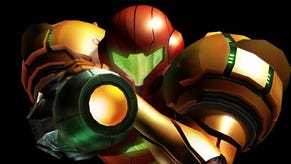Metroid Prime
Hallelujah! The Cube is saved!
March snuck up on us like a second Christmas this year, with a barrage of new and exciting games across all formats. We must confess though that much of our excitement was centred on Retro Studios GameCube debut. Having spent several months labouring over a US version, we were excited to finally get our hands on the closely guarded PAL release this week.
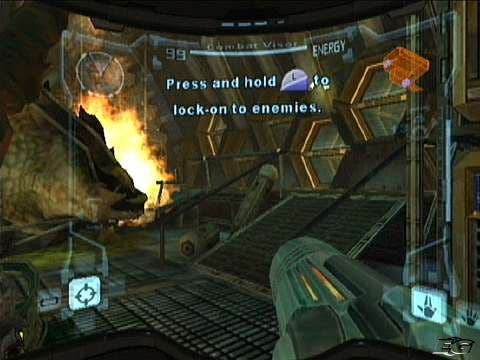
The bitch is back
Like all top releases, Metroid Prime is very much its own game. There's no need to be intimidated by the dynasty at work here. Anybody who reads the first couple of pages of the manual will understand pretty much the entire history of the series, and by the time you descend to the surface of planet Tallon IV, you'll have mastered the mechanisms involved in playing Prime.
Tallon IV is a bit like a certain ring-shaped world on another console, with the former occupants long since departed, and the surface laden with meticulously placed devices to aid progression, deposited in their wake. And also like said ring, it's a hotly contested place, with several species of aggressor and plenty of indigenous mutants, victims of the radioactive Phazon thrown up by the meteor strike that ousted the ruling Chozo.
The winged Chozo - sanctimonious, benevolent weirdoes that they were - prophesied that a great warrior would one day rescue Tallon IV from its plight. The manual implies that this is where you come in, as bounty hunter Samus Aran, arriving by spaceship on an orbital platform above the planet's surface.
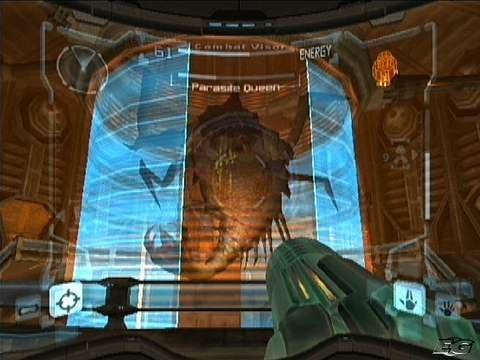
Buccaneering
This opening section of the game is more of a short, sharp tutorial, but it's also a microcosm for the rest of the game. By the end of it you'll have done much exploring; fought through corridors and concourses, past sentry guns, utilised the various functions of your suit and arsenal, rolled around in a morph ball, studied abandoned experiments and admired limp Space Pirate corpses strewn about the Metroid-plundered laboratories.
In the grandest of adventure game traditions, you'll come up against a few puzzles, overcome an early, sight-setting boss encounter with a giant, Phazon-chundering Parasite Queen, fight to escape through larva-infested tunnels or by platforming your way across lab gangways, all against the clock, and crash-land on the surface of the planet as the platform explodes into a million pieces. Quite an opening.
And as if the sights, sounds and tasks ahead of you weren't enough, there's a whole new control mechanism to contend with. Unlike Halo, and other console shooters, Metroid uses the left thumb stick for all movement, while the L trigger locks you onto a target and allows you to circle-strafe, or strafe normally in the absence of targets, and the A and B buttons control your beam and missile weapons. Only by clutching the R trigger can you look up and down. Is this restrictive, you're probably asking? Not really, because much of your sightseeing is just that - an exercise in scanning objects above or below.
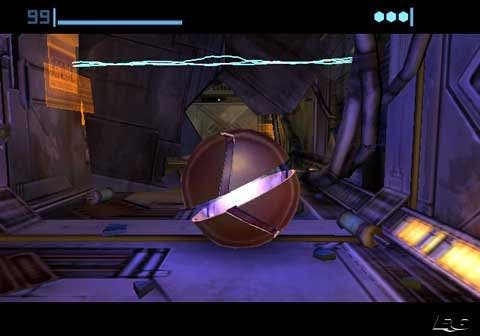
Lie still for a second…
Scanning is one of the most crucial elements of Metroid Prime. Whenever you're faced with a new area, you hit left on the directional pad, locking Samus' visor into scanning mode. By holding R and wiggling the stick you manipulate a centred viewfinder, which casts holographic icons over actionable items. These then reveal clues about the surrounding area, activate objects nearby, or decipher Chozo text and shed some light on the sorry tale of Tallon IV. All the information is stored in a database which can be accessed at any time - and you'll spend a lot of time here unravelling the mysteries of Tallon IV.
What's more, scanning enemies and bosses reveals weak points. Enemies vary from level to level, but instead of just varying animations and susceptibility to ammo types, they have different attack strategies and you'll need to adjust your tactics accordingly. Flying bugs are best dealt with by lots of alternative tapping of lock and fire, but when you first meet Pirates with jetpacks, for example, you'll need to find some cover and return fire like you're Clint Eastwood.
It helps later on when you've amassed the various arm cannon upgrades - the plasma, ice, power and wave beams - which allow you to open doors of all matching colours, or when you can match them with items like the rocket launcher, freezing enemies and then shattering them like panes of glass.
Likewise, bosses are tricky to defeat, and far more than an exercise in ammo expenditure. In some cases, you'll have to look to the environment for ideas, whilst in others your thermal visor or scanner may provide clues.
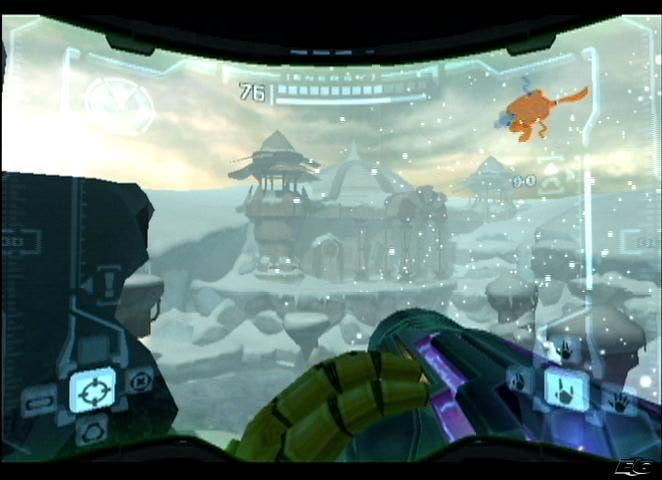
The rules of Prime club
It's a very multi-faceted game as you can tell, but there are two central principles that drive progression. The first of these is that some new upgrade, a new toy to play with, could lurk around the next corner, and each of them is increasingly useful and exciting to use. Find the morph ball, and maybe you can get through those tiny tunnels to access the rooms your map insists you should check out. Find the thermal visor, and maybe you can get past that darkened room with its ghostly enemies. Find the X-ray, and maybe you'll spot something new to help you past your current dead end. Or perhaps if the next room yields some missiles, you can go back and open that 'blast door' outside.
Levels, if you can call them that, are linked by lifts and passages, and are labyrinthine and vast, rarely giving up all their spoils in one pass. The nature of Metroid has you backtracking all over Tallon IV, fighting the same respawning beasties and gradually figuring out puzzles, defeating bosses and accumulating enough kit to open doors or get through chinks to access new areas.
Often, you're faced with a problem you can't figure out, and you really have to scour your map - a scalable, rotatable 3D schematic accessed via the Z button - for unchecked rooms and forgotten doors. But almost always, a bit of lateral thinking, the application of a new upgrade or some visor inspection is enough to assure your progress. And at times, the game just wants you to leap around a bit! The amount of platforming required is often quite surprising; as you find yourself advancing up a massive, Phazon-rooted tree, scrambling round its trunk like a spiral staircase whilst scouring the adjacent walls for symbols to unlock the door at the top - another example of how the game keeps you on your toes, forcing you to multi-task like all good explorers.
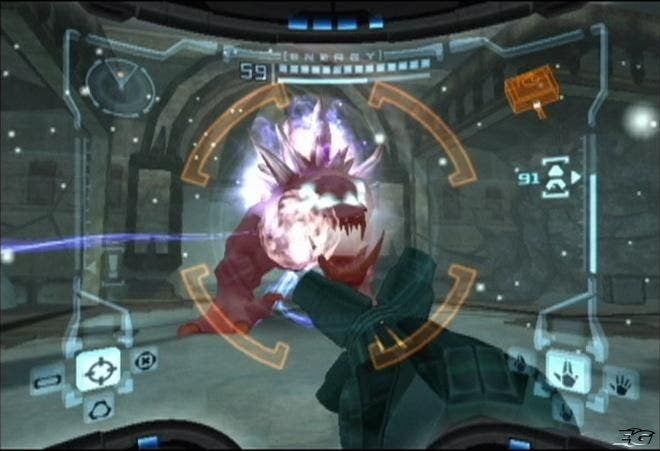
Sensory overload
Getting back on track - though the reward structure is balanced and intelligent, the game's consistently alluring visuals are an equally important incentive to continue. They've been lavished much attention by gamers, journalists and even developers the world over, but it isn't until you experience the game for yourself that the hype makes sense.
There are a million and one awe-inspiring moments saturated with detail waiting to be uncovered in Metroid Prime. Each new area is like an art exhibit, from the summery, creeper-ensnared temple ruins, with dusty, crumbling masonry and bubbling Phazon lakes, to the lava-soaked, hazy Magmoor Caverns, so hot they require suit upgrades just to access, and the snowy canyons of Phendrana Drifts.
Everything Metroid tries, it conquers with aplomb. Thermal visors explode with flare and Samus' face grimaces in the reflection as rockets rip through a damaged wall, and alien innards splatter your targeting pane as you get too close to your victims. And the creatures of Tallon IV, both alien and indigenous, are varyingly rendered and each unique. Hornet-like buzzing nasties beat their wings and zip from the sky when clobbered; the mechanised Space Pirates go berserk when electrified by your Wave Beam, and as for the bosses…
Bleeding eyes
It really would be a crime to spoil these magnificent encounters for you. We've already touched on the gameplay implications of these face-offs, but from a visual standpoint the payoff is even greater. Even the first real boss, the giant plant Flaagrha, has multiple attack patterns, and squirms miserably as you exploit its Achilles' heel, before growing like a sunflower on speed as it comes back for more.
On the whole though, it's the incidental detail that provides the most memorable moments for crusty Metroid veterans like us. The sight of a dead Space Pirate slumped, bloodily against a wall; wires and the sparking electrical innards of a level poking through the ceiling; clumsily piled scrap metal in a corridor; or even just an "empty room", with cracked floors and creepers snaking their way around to the very top, where blocks have slipped from the masonry, dousing everything in light from the sky above - a location working harder to fit in than a thousand prefabricated gnome-ridden grottos in Halo.
Perhaps our favourite touches though are those on Samus Aran herself. Gases billow against her suit's visor; electrical attacks fizzle and char, as the bounty huntress raises her arm to protect her face; and the light even reflects off her shiny metallic ball shape as she rolls through tunnels like a marble chase-cam.
If there's a more beautiful game on Nintendo's console, then we haven't seen it, and if there's a better realisation of a sci-fi fantasy in gaming, we want to hear about it. It's a 3D update that relishes its 2D, cartoon past, and has had a comparable effect on us to that of Doom when we first played the shareware version all those years ago. No exaggeration.
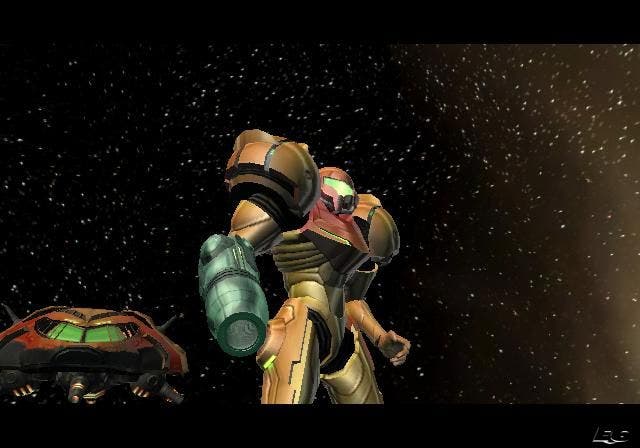
Spellbinding
All in all, there are many, many hours of exploration and fun to be had in Metroid Prime. It's a game that never stops giving, and you'll delight in virtually every activity it throws at you. It's a pure gamer's game, sheathed in the best aspects of everything you've played before across many genres. The secret is in the arrangement - the first bite, as they say, is with the eye, and this eases the process of chewing your way through the increasingly juicy filling.
Of course, one of the most difficult things about reviewing any console's best game - and that is what we're dealing with here - is ascertaining why it keeps your attention, not why it grabs you in the first place.
When it comes to Metroid Prime, however, I think it's an easier job than explaining Soul Calibur's undying attraction, or the magic behind Ocarina of Time. Simply put, no game has ever been so complete, adorned with so much beauty, and at the same time employed familiar aspects of multiple genres with such seamless belonging. It's a game awash with variety, and yet nothing feels out of place.
Almost everything is right and many tastes are indulged. There's a moody soundtrack, a hyperactive title screen, the Monkey-topping physics of the morph ball - and it even has GBA connectivity. Finish both Prime and Metroid Fusion, released in November, and you can swap Samus' Fusion suit into Prime and unlock the entire NES Metroid game on the GBA. Easily the best thing we've done with that cable so far.
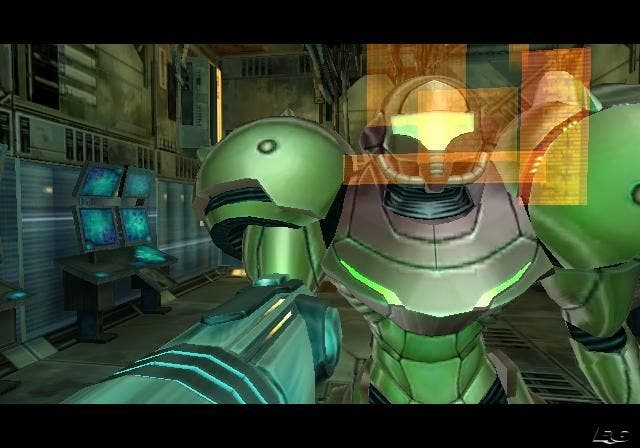
Nintendo cries 'bank'
To be honest, we could go on about Metroid Prime all day, but we're sure you're pretty sick of reading glowing, superlative-bound reviews of the game you really must buy today. But the thing is, it's a game so mesmerising that it has stirred emotion in even the curmudgeonliest of games writers. It's as if every gamer with a copy of Word and an import Cube has tried to say something new, inspirational or memorable about a game which came out of nowhere and hit every single one of the right buttons. It's a game that's inspiring increasingly breathless masturbation of the world's vocabulary, and if it's good enough to remind us - the surly, anal, tempestuous critics - why we got into games writing in the first place, then that's a pretty flattering compliment, and should tell you all you need to know.


Kristan's take
You might have heard about Metroid Prime. It's the game that kept US and import gamers happy over Christmas; the game that - in all probability - would have saved the machine's arse had it come out in Europe four months ago. There's little point waiting until the end of the review to tell you it's a good game, because you'll have read that already a hundred times.
What's possibly more useful is for us to try and pinpoint why it's so good, and maybe throw a few spanners in the works to point out a few misgivings that others may have glossed over, as excited gamers tend to when they passionately devote themselves to a game.
It's hard to know where to start when you're forced to pinpoint the game's excellence, such is the stunning amount of depth contained within Retro's classic. There. We said it already. Three paragraphs in and superlatives are flying around like Morph Bombs.
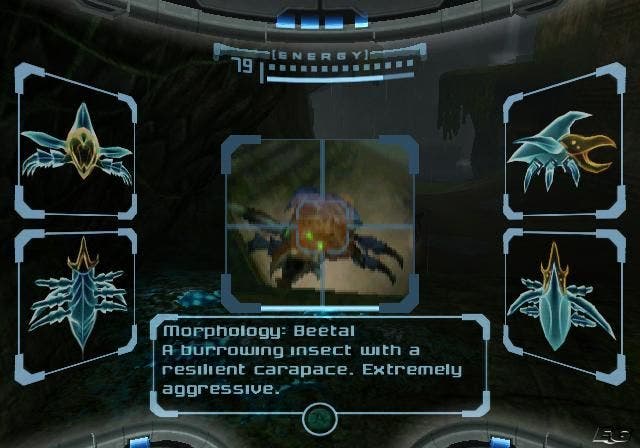
Lavish
The easiest, most basic area to lavish praise on Metroid Prime is the graphics. It just oozes class on every level, and will consistently have you gasping in admiration at the endless attention to detail. Seeing the world through the helmet of Samus is a masterstroke from the off, giving Retro Studios the opportunity to show off some absolutely delicious effects. Everything looks incredibly convincing: emerge from underwater and droplets run off the front of your visor. Walk next to a volcanic vent, and sweat fogs up the inside. Walk near a cascading waterfall, and get covered in spray. They may be incidental touches, but they quickly immerse you into the environment, and make it all the more convincing.
On a similar level, there are vast array of creatures, ranging from scurrying beetles to giant mutated monsters, and everything in between, all supremely detailed, even at the closest proximity and a brilliant advert for the capabilities of the Cube. The variety in the scenery is tackled with aplomb too, and managing to display even those old fallbacks of Ice, Lava, and Desert with a degree of polish and detail that puts other games to shame. The overall look and feel of the game is sufficiently different from the common herd to make it feel new; which is always a pleasure after 200 Quake 3-based games.
The controls are also superb too, managing to make the most of the GameCube's pad, with a configuration that feels natural within minutes. At first, having to click the R button to look around feels like an unnecessary annoyance, but Retro has come up with a system that is not only different from its many peers, but in some respects is an improvement. The lock on system allows you to engage in some pretty hardcore fire fights, always giving you the impression that you're in control; and the ability to circle strafe, and dash, around your target makes combat entertaining, and never at any stage a chore. Sure, the boss fights can be a massive challenge, but you get there in the end, and like the rest of the game, the learning curve is very well judged.

Awestruck
The sense of awe and wonder in the world of Metroid Prime is a feeling we've not had since the days of Half Life and the original Unreal. Scanning artefacts and creatures gradually gives you an insight into how this planet ended up in this state, and builds a narrative in an intelligent and almost subliminal way. It won't be to everyone's taste, and maybe the thought of wading through endless notes strikes you as a tad dull. Sometimes it is; sometimes you just long for a cut scene to tell the story in a more movie-esque, coherent sense, but in other ways the piecing together of scraps of information makes you feel like it's your discovery - your reward for looking in every nook and cranny.
Perhaps the strongest point of Metroid Prime is the way the upgrade system works. Almost everything you achieve in the game is rewarded with a new weapon, or upgrade, suddenly offering you the chance to go back to out of reach areas of old levels to scour for new sections and even more upgrades. The carrot and stick design works a treat, and even 15 hours in you'll barely be scratching the surface, desperate to claim the next unknown upgrade. Once you're fairly well equipped, it really begins to sink in how cleverly designed the levels are. However out of reach or inaccessible certain sections look, you know that you'll have the ability to reach them at some point. There's a massive amount of satisfaction for your unflinching efforts, and all the while displayed with a level of detail bordering on perfection.
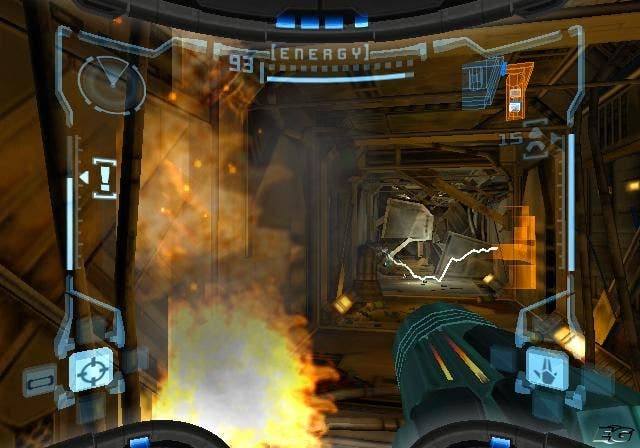
Perfection? Not quite
But. You were waiting for the but, and here it is. Despite the slightly hysterical coverage Metroid Prime has been getting everywhere, there are some areas that could have been improved and some that just downright annoy. The first is the game's insistence on respawning all of its enemies, no matter how many times you've cleared an area. Up they sprout, again and again, and it's plainly a tedious mechanic to make the game still feel alive and busy, even when you've slaughtered every living soul possibly dozens of times. This, in itself, wouldn't be an issue, were it not for the necessity to continually backtrack and revisit every part of every level multiple times, in order to use your latest gadget and reach some previously unattainable area.
In addition, the game's intricate level structure can, to begin with at least, trip you up. This is not a game that you can just breeze through, partly due to the fact that it's big, but also thanks to some questionable signposting. The game does, to be fair, occasionally chip in with hints of where you should be heading next, but often it merely points to a section of the map that you can't even access. More often than not, the real goal is to get your next gadget, thus allowing you to head for the area in question. It's no exaggeration to note that you can wander backwards and forwards through the game world for hours - tediously encountering the same enemies again and again - until the penny drops as to exactly what the purpose is. After a while you begin to learn the way the game wants you to play, but it can be a painful first few hours before a pattern emerges.
You could just as easily argue that the game's lack of narrative structure and decision to abandon the spoon feed approach of a check list of mission goals gives the game a distinctly refreshing slant: one of exploring a strange new world, gradually understanding what's going on as you search its hidden depths. This is all true, but in the context of a modern game it also contributes to making it more frustrating and long-winded than it would otherwise be. We don't recall anyone berating Rare for giving clear mission goals in GoldenEye; and somehow it just comes across as a needless omission. Certainly, the option of having such a basic facility as a set of mission goals would aid the less patient gamer enormously - or the less time rich gamer. Focusing the game on the time rich, patient, persistent hardcore seems bloody-minded for what is, nevertheless, a classic.
For many of you, some of you perhaps hardcore Metroid veterans, none of this will apply - but don't be surprised if you spend your first few hours with the game wondering what all the fuss is about - as Tom says, it's a gamer's game, and the wide-eyed noob may be in for a rude awakening if they're expecting another friendly, accessible Halo-style romp.
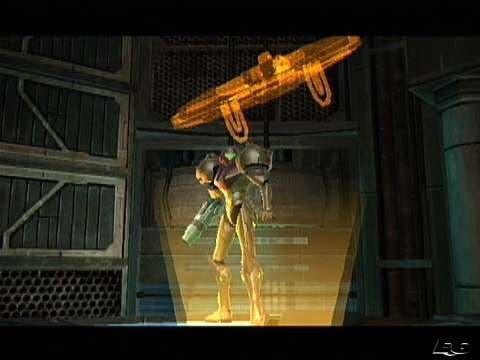
A landmark
Despite all the early niggles, the bottom line is Metroid Prime is a landmark next generation title and builds itself into one of the best games we've ever seen. The true mark of its genius is that even when it annoys the hell out of you, the compulsion to keep on playing never wanes. The punishment-reward relationship is ever present, (and arguably has too much of the former and not enough of the latter at times) but the more you play it, the more abilities you unlock, and the more satisfying the game becomes. Would we buy a GameCube to play it? At the crazy prices doing the rounds at the moment it would criminal not to. Patience is a virtue; buy Metroid Prime and be virtuous.
Metroid Prime screenshots (Cube)
Metroid Prime first impressions (Cube)
Shop:Buy this game for £34.99 from the Eurogamer Shop.



